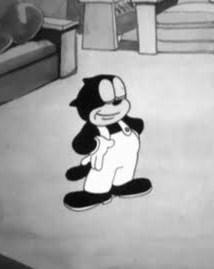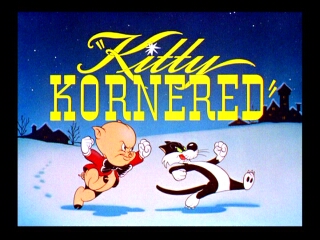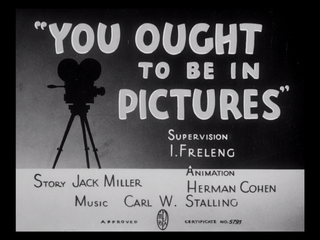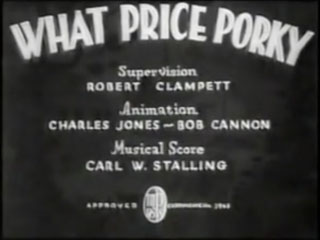Related Research Articles

Porky Pig is a cartoon character in the Warner Bros. Looney Tunes and Merrie Melodies series of cartoons. He was the first character created by the studio to draw audiences based on his star power, and the animators created many critically acclaimed shorts featuring the character. Even after he was supplanted by later characters, Porky continued to be popular with moviegoers and, more importantly, the Warners directors, who recast him in numerous everyman and sidekick roles.

Porky in Wackyland is a 1938 Warner Bros. Looney Tunes animated short film, directed by Bob Clampett. The short was released on September 24, 1938, and stars Porky Pig venturing out to find the last do-do bird, which he finds in Wackyland, a land that makes no sense located in Darkest Africa.

Robert Emerson Clampett Sr. was an American animator, director, producer and puppeteer best known for his work on the Looney Tunes animated series from Warner Bros. as well as the television shows Time for Beany and Beany and Cecil. He was born and raised not far from Hollywood and, early in life, showed an interest in animation and puppetry. After dropping out of high school in 1931, he joined the team at Harman-Ising Productions and began working on the studio's newest short subjects, Looney Tunes and Merrie Melodies.
Charlie Dog is an animated cartoon character in the Warner Brothers Looney Tunes series of cartoons. The character was featured in nine cartoons between 1941 and 1958. He is generally characterized as a friendly wise guy.

Petunia Pig is an animated cartoon character in the Looney Tunes and Merrie Melodies series of cartoons from Warner Bros. She looks much like her significant other, Porky Pig, except that she wears a dress and has pigtailed black hair.

Beans the Cat is an animated cartoon character in the Warner Bros. Cartoons series of cartoons from 1935–1936. Beans was the third Warner Bros cartoon character star after Bosko and Buddy. He was voiced by Billy Bletcher. He was created by director Friz Freleng. The character was featured in nine cartoons made in 1935 and 1936.

Hillbilly Hare is a 1950 Warner Bros. Merrie Melodies cartoon directed by Robert McKimson. The short was released on August 12, 1950 and stars Bugs Bunny.

Kitty Kornered is a 1946 Warner Bros. Looney Tunes cartoon, directed by Robert Clampett. The short was released on June 8, 1946, and stars Porky Pig and Sylvester.
Warner Bros. Cartoons, Inc. was an American animation studio, serving as the in-house animation division of Warner Bros. during the Golden Age of American animation. One of the most successful animation studios in American media history, it was primarily responsible for the Looney Tunes and Merrie Melodies series of animated short films. The characters featured in these cartoons, including Bugs Bunny, Daffy Duck, and Porky Pig, are among the most famous and recognizable characters in the world. Many of the creative staff members at the studio, including directors and animators such as Chuck Jones, Friz Freleng, Robert McKimson, Tex Avery, Robert Clampett, Arthur Davis, and Frank Tashlin, are considered major figures in the art and history of traditional animation.

You Ought to Be in Pictures is a 1940 Warner Bros. Looney Tunes short film directed by Friz Freleng. The cartoon was released on May 18, 1940, and stars Porky Pig and Daffy Duck.
Tin Pan Alley Cats is a 1943 Warner Bros. Merrie Melodies directed by Bob Clampett. A follow-up to Clampett's successful Coal Black and de Sebben Dwarfs, released earlier in 1943, Tin Pan Alley Cats focuses upon contemporary themes of African-American culture, jazz music, and World War II, and features a caricature of jazz musician Fats Waller as an anthropomorphic cat. The short's centerpiece is a fantasy sequence derived from Clampett's black and white Looney Tunes short Porky in Wackyland (1938).
Jeepers Creepers is a 1939 Warner Bros. Looney Tunes police comedy animated short, directed by Robert Clampett. The short was released on September 23, 1939, and stars Porky Pig.

The Case of the Stuttering Pig is a 1937 Warner Bros. Looney Tunes animated cartoon directed by Frank Tashlin. The short was released on October 30, 1937, and stars Porky Pig and Petunia Pig.
This is a list of all cartoons featuring Porky Pig. Directors are listed in parentheses.

Wagon Heels is a 1945 Warner Bros. Merrie Melodies short directed by Bob Clampett. The short was released on July 28, 1945, and stars Porky Pig.
A Coy Decoy is a 1941 Warner Bros. Looney Tunes cartoon, directed by Bob Clampett. The cartoon was released on June 7, 1941, and stars Porky Pig and Daffy Duck.

What Price Porky is a 1938 Warner Bros. Looney Tunes cartoon directed by Bob Clampett. The cartoon was released on February 26, 1938, and stars Porky Pig and Daffy Duck.

Wise Quacks is a 1939 Warner Bros. Looney Tunes animated short film directed by Bob Clampett released on August 5, 1939.
Porky's Picnic is a 1939 Warner Bros. Looney Tunes animated cartoon directed by Bob Clampett. The short was released on July 15, 1939, and stars Porky Pig and Petunia Pig.
Scalp Trouble is a 1939 Warner Bros. Looney Tunes cartoon directed by Bob Clampett. The cartoon was released on June 24, 1939, and stars Porky Pig and Daffy Duck.
References
- ↑ Beck, Jerry; Friedwald, Will (1989). Looney Tunes and Merrie Melodies: A Complete Illustrated Guide to the Warner Bros. Cartoons. Henry Holt and Co. p. 93. ISBN 0-8050-0894-2.
- ↑ Lenburg, Jeff (1999). The Encyclopedia of Animated Cartoons. Checkmark Books. pp. 124–126. ISBN 0-8160-3831-7 . Retrieved 6 June 2020.
- 1 2 3 4 5 6 7 8 9 10 11 12 13 14 15 16 17 18 Frierson, Michael (1998), "The Image of the Hillbilly in Warner Bros. Cartoons of the Thirties", in Sandler, Kevin S. (ed.), Reading the Rabbit: Explorations in Warner Bros. Animation, Rutgers University Press, pp. 96–100, ISBN 978-0813525389
- 1 2 3 4 Shull, Michael S.; Wilt, David E. (2004), "Filmography 1939", Doing Their Bit: Wartime American Animated Short Films, 1939-1945, McFarland & Company, pp. 95–96, ISBN 978-0786481699
- 1 2 3 4 5 Hollis, Tim (2008), "Hillbilies Go Hollywood", Ain't That a Knee-Slapper: Rural Comedy in the Twentieth Century, University Press of Mississippi, p. 82, ISBN 978-1604739534